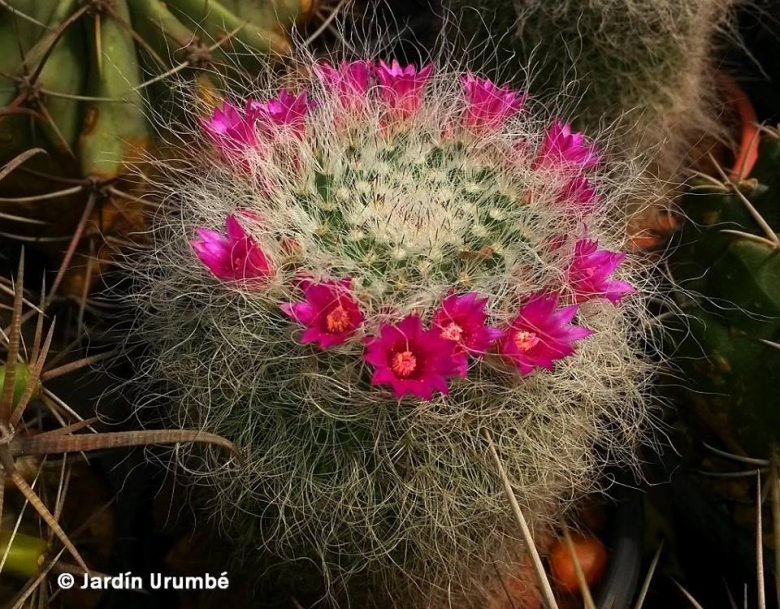Accepted Scientific Name: Mammillaria hahniana Werderm.
Monatsschr. Deutsch. Kakteen-Ges. 1: 77 77 1929

Mammillaria hahniana var. giselana Photo by: Alexander Arzberger
Origin and Habitat: Tarajes, Guanajuato, Mexico.
Synonyms:
See all synonyms of Mammillaria hahniana
Description: Mammillaria hahniana var. giselanaSN|22358]]SN|33167]] is an old variety name described by Neale in 1935. According to the author's description the variety distinguishes by thinner axillary hairs, that do not conceal the green tubercles. These axillary hair are less than 15 mm long and each areola has up to 40 radial spines. However in Mammillaria hahnianaSN|33167]]SN|22358]] the density and length of hair and spines varies considerably also in plants of the same batch. The var. giselana and the standard M. hahniana are undoubtedly very closely related and very similar in many ways, showing but small differences. It is very difficult to discriminate specific characteristics as to justify their varietal separation. The different length of the bristles and the number of radial spines are variable from individual to individual and do not justify the division in varieties. Up to date most authors have dismissed var. giselana as perhaps not worthy of even varietal status, but it still has a value for a collector because they identify plants with particular characters.
Subspecies, varieties, forms and cultivars of plants belonging to the Mammillaria hahniana group
 Mammillaria hahniana Werderm.: has 20-30 radials spines, one central spine (rarely more), and purplish red flowers. Distribution: Queretaro, Guanajuato, and Tamaulipas.
Mammillaria hahniana Werderm.: has 20-30 radials spines, one central spine (rarely more), and purplish red flowers. Distribution: Queretaro, Guanajuato, and Tamaulipas. Mammillaria hahniana f. albiflora hort.: has white flowers. Garden origin.
Mammillaria hahniana f. albiflora hort.: has white flowers. Garden origin.- Mammillaria hahniana subs. bravoae (R.T.Craig) D.R.Hunt: has 28-30 radials, usually 2 central and deep pink flowers. Distribution: Rio Blanco region of Guanajuato.
 Mammillaria hahniana var. giselana W.T.Neale: ha thinner hair less than 15 mm long and has up to 40 radial spines. Distribution: Tarajes, Guanajuato, Mexico.
Mammillaria hahniana var. giselana W.T.Neale: ha thinner hair less than 15 mm long and has up to 40 radial spines. Distribution: Tarajes, Guanajuato, Mexico.- Mammillaria hahniana subs. mendeliana (Bravo) D.R.Hunt: has 2-4 central spines with very reduced or no radials, and pale pink flowers. Distribution: Guanajuato and Queretaro.
- Mammillaria hahniana var. werdermanniana F.Schmoll ex R.T.Craig: has axillary hairs up to 25 mm long, angular tubercles, and outer petals shortly ciliated, stigmas pink-brown. Distribution: Guanajuato, Mexico.
 Mammillaria hahniana subs. woodsii (R.T.Craig) D.R.Hunt: has 25-30 radial spines, usually has 2 centrals, and pink flowers. Distribution: Near Hacienda de Tarajeas, Guanajuato.
Mammillaria hahniana subs. woodsii (R.T.Craig) D.R.Hunt: has 25-30 radial spines, usually has 2 centrals, and pink flowers. Distribution: Near Hacienda de Tarajeas, Guanajuato. Mammillaria saetigera Boed. & Tiegel: has shorter axillary hairs (less than 2.5 cm long), radial spines 15-20, central spines 2. Outer perianth segments shortly ciliated. Stigma lobes pinkish-brown . Distribution: Queretraro (Arroyo Seco and Sierra de Jalpan).
Mammillaria saetigera Boed. & Tiegel: has shorter axillary hairs (less than 2.5 cm long), radial spines 15-20, central spines 2. Outer perianth segments shortly ciliated. Stigma lobes pinkish-brown . Distribution: Queretraro (Arroyo Seco and Sierra de Jalpan).
Bibliography: Major references and further lectures
1) Backeberg.C., “Die Cactaceae” 5 : 3207-3209, 1961
2) Craig R.T., “The Mammillaria Handbook”, p. 110-112, 1945
3) Hunt R., “Jména mamilárií v běžném užívání I. část A-M”
4) Krainz H., “Die Kakteen”, CVIIIc, 1. 5. 1957
5) Pilbeam J., “Mammillaria. A collector`s guide”, p. 69-70, 1981
6) Karel Crkal. “MAMMILLARIA HAHNIANA Werderm. var. HAHNIANA” <http://www.cact.cz/galerie_test/detail.php?id=152>
Cultivation and Propagation: It is a rapid growing species that will form large clumps rather rapidly when compared to other Mammillaria species. Needs lots and lots of space to grow. Water regularly in summer, but do not overwater (Rot prone) Use pot with good drainage and a very porous potting media, keep dry in winter. Feed with a high potassium fertilizer in summer. It is quite frost resistant if kept dry, hardy as low as -5° C (some reports give it hardy to -12°C) Outside full sun or afternoon shade, inside needs bright light, and some direct sun.
Use and Trade: This cactus is used as an ornamental, and its fruit are eaten by humans.
Propagation: Division, direct sow after last frost.











